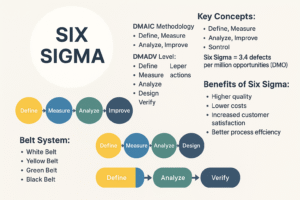In today’s competitive business environment, every company wants to improve the quality of its products and services. To achieve this goal, one powerful method is Six Sigma. Let’s understand what Six Sigma is, how it works, and what benefits it offers.
 What is Six Sigma?
Six Sigma is a quality management technique focused on eliminating defects and bringing consistency to processes. Its aim is to make processes so efficient and perfect that errors are almost zero.
Six Sigma Methodology:
What is Six Sigma?
Six Sigma is a quality management technique focused on eliminating defects and bringing consistency to processes. Its aim is to make processes so efficient and perfect that errors are almost zero.
Six Sigma Methodology:
 What is Six Sigma?
Six Sigma is a quality management technique focused on eliminating defects and bringing consistency to processes. Its aim is to make processes so efficient and perfect that errors are almost zero.
Six Sigma Methodology:
What is Six Sigma?
Six Sigma is a quality management technique focused on eliminating defects and bringing consistency to processes. Its aim is to make processes so efficient and perfect that errors are almost zero.
Six Sigma Methodology:
- DMAIC: (For improving existing processes)
- Define – Clearly define the problem.
- Measure – Measure current performance.
- Analyze – Identify the root causes of the problem.
- Improve – Implement solutions and improve the process.
- Control – Monitor the process to sustain improvements.
- DMADV: (For developing new processes or products)
- Define – Understand customer requirements.
- Measure – Identify critical factors.
- Analyze – Analyze available options.
- Design – Create the best possible design.
- Verify – Test and validate the design.
- White Belt – Basic understanding.
- Yellow Belt – Works at the team level.
- Green Belt – Leads smaller projects.
- Black Belt – Manages complex projects.
- Master Black Belt – Acts as a mentor and coach across the organization.
- Increased process efficiency
- Reduced costs
- Improved customer satisfaction
- Significant reduction in defects and errors
- Data-driven decision making


Leave a Reply